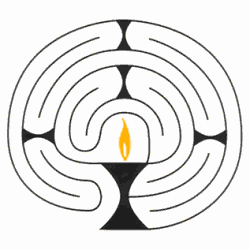

The original design for the Chalice Labyrinth is from Bob Peach, who maintains the Georgia Labyrinths website. Bob offers the original design (© 2000) freely to anyone who wants to reproduce it. Bob has blessed the new Flaming Chalice version, which is also available for free reproduction.
The following extract from a letter by Dick to Bob discusses the design’s origin.
I had been following up on links to various material on labyrinths, finding myself more and more caught up in the designs. I’ve never been a labyrinth walker myself, but I found myself entranced by the designs as geometric shapes. Some moved me more than others; Chartres, of course, is powerful, as are many of the older designs. But most of the newer ones do not touch me as deeply—not steeped enough in time’s test, I suppose.
Then I came across your Chalice Labyrinth. This one did catch my imagination. It has the power: a balance, an elegance, a sense of energy that engaged me the moment I laid eyes on it. And I liked the creative manipulation of the lower labrys into a chalice. But the chalice suggested another approach for me, since one of the prominent symbols in the tradition of Unitarian Universalists is a flaming chalice (of the kind used by the Romans: a vessel of oil lit as a lamp). The illuminating flame is a powerful symbol for me—and this, I thought, if I were a walker, is what I would seek at the center of the labyrinth. So, just to see what it would look like, I made a copy of the design and placed a flame at the center.
When I sat back and looked at the result, I found myself looking at something that quite surpassed my intent or expectations. I was struck by how well it worked: the pathways became air currents that seemed almost to shimmer with the heat of the flame—and the whole thing reminded me powerfully of a halo, or of the sun on a frosty day surrounded by sun dogs and ice halos. I also saw subconsciously a figure with a head of flame and outstretched arms—bringing to mind a line from Amergin’s chant: I am the God who created in the head the fire. The pathways in the lower half suggested hands reaching out to enfold or cradle the flame-headed figure. The more I looked at it the more things bubbled out of my subconscious mind.
Even without the flame, I like this labyrinth a lot. On the practical side, it’s an excellent layout for a small labyrinth, where something like Chartres wouldn’t fit or would simply be too big an undertaking. And it is complete in itself—it doesn’t feel like a reduced version of something else.